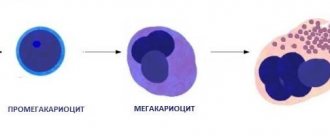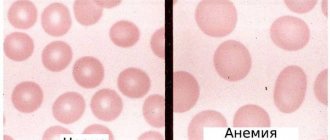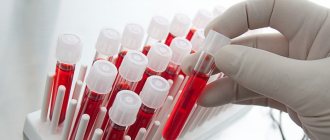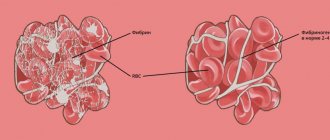The protein component does not have its own color and dissolves in blood serum. Fibrinogen is the basis of blood clots; it is formed in the liver; its renewal is recorded every 3 days. The amount of the element is regularly checked by laboratory diagnostics. A critical minimum or maximum amount of a component can cause serious disruptions in the functioning of the body, provoke long-term bleeding or the formation of blood clots on the inner walls of blood vessels.
The role of fibrinogen in the body
Fibrinogen activation occurs when blood vessels are damaged. This begins the process of formation of a blood clot, in which platelets take an active part. These cells stick together, forming a so-called red blood clot. Thrombin-activated fibrinogen is then transformed into fibrin strands, which strengthen the primary blood clot, thereby forming a white thrombus.
In addition to stopping bleeding, fibrinogen takes part in the following processes in the human body:
- restoration of damaged soft tissues: skin, mucous membranes, muscles, etc.;
- dissolution of the blood clot during tissue regeneration - fibrinolysis;
- formation and development of new blood vessels - angiogenesis;
- strengthening the walls of blood vessels, counteracting inflammatory changes in them.
D-dimer as a marker of thrombus formation after Covid
“Often in patients both in the acute period and after suffering a new coronavirus infection, an increase in D-dimer may be observed in blood tests. D-dimer is the breakdown product of fibrin, a small protein fragment present in the blood after the blood clot has broken down. If the D-dimer is normal, this practically excludes thrombosis, and if it is elevated, thrombosis or other causes are possible. Therefore, the decision to prescribe or continue anticoagulants after treatment for coronavirus should not be made solely on the basis of this indicator. We need to assess the patient's complaints and his general status: if, along with an increase in D-dimer, there are also symptoms indicating thrombosis, additional studies are necessary (for example, CT angiography of the pulmonary artery to exclude pulmonary embolism, duplex scanning of the veins of the lower extremities to exclude thrombosis of the veins of the lower extremities).
Kogrusheva Yulia Petrovna
expert
clinic "Ogni Olympa" therapist, gastroenetrologist
Congenital disorders of fibrinogen synthesis
Rare congenital diseases affecting the synthesis process and functionality of fibrinogen are:
- Dysfibrinogenemia. It is manifested by reduced production of this protein by liver cells due to a genetic mutation of the F1 gene located on the q28 region of chromosome 4. With this pathology, the liver produces abnormal dysfunctional fibrinogen, which is difficult to degrade when converted into fibrin or cannot function normally in the coagulation cascade. Dysfibrinogenemia increases the risk of blood clots or, in rare cases, causes bleeding and poor wound healing².
- Congenital hypofibrinogenemia. Leads to a decrease in fibrinogen production in the liver. People with this condition may experience spontaneous bleeding (such as from the nose or gums)³.
- Congenital afibrinogenemia. Pathology accompanied by acute lack of fibrinogen. Episodes of heavy bleeding occur, especially in infancy or early childhood: from the umbilical cord, nose, after surgical procedures. Large hematomas (bruises) appear even with minor bruises.
Figure 1. Blood coagulation diagram. Image: rob3000/Depositphotos
Solution
Deviation from the norm of fibrinogen does not allow us to draw conclusions about a hidden disease. The indicators make it possible to identify increased or decreased results, but not to detect the original source of the disease. To make a correct diagnosis, the patient must undergo additional laboratory diagnostic examination. Correct identification of existing pathologies will solve the problem.
Doctors warn that ignoring the altered level of fibrinogen and refusing to undergo therapeutic procedures provokes external and internal bleeding (with reduced results) or accelerated formation of blood clots (with an increased amount).
The attending physician makes the final diagnosis and selects a treatment regimen. By seeking professional help in a timely manner, the chances of complications and consequences are significantly reduced.
Blood test for fibrinogen
Measuring the level of fibrinogen in blood plasma is most often performed as part of a coagulogram, a blood test that evaluates blood clotting functions. Venous blood is used for the study. In the analysis form, fibrinogen is often indicated by its full name in Latin or Cyrillic. The amount of this protein varies in grams per liter of blood plasma (g/l).
In the vast majority of cases, fibrinogen levels are measured as part of a coagulogram, a comprehensive study that evaluates the various stages of blood clotting. In addition to this analysis, the coagulogram also includes: free protein S, factor VIII, protein C, plasminogen, lupus anticoagulant, antithrombin III, D-dimer, prothrombin, thrombin time, APTT (activated partial thromboplastin time), INR (international normalized ratio).
In general, there are two options for laboratory blood tests for fibrinogen³:
- Fibrinogen activity test. Evaluates the part of the coagulation process in which soluble fibrinogen is converted into fibrin filaments. It measures the time it takes for a fibrin clot to form after adding a standard amount of thrombin to a blood sample (plasma). The time it takes for a clot to form directly correlates with the amount of active fibrinogen. An increase in the interval for clot formation may be due to decreased levels of normal fibrinogen or because it is not functioning properly.
- Fibrinogen antigen test. Measures the level of functional and dysfunctional fibrinogen in the blood. In most cases, it is used as a follow-up test to determine whether the decrease in fibrinogen activity is due to insufficient fibrinogen or a malfunction of fibrinogen.
What is the difference between fibrinogen, D-dimer, and fibrin breakdown products (FDP) tests?
Determination of fibrinogen activity allows one to evaluate the conversion of fibrinogen to fibrin. Fibrinogen antigen testing measures the amount of factor I dissolved in the blood before it is converted to insoluble fibrin and forms a fibrin network. D-dimer and FDP tests help assess the state of the fibrinolytic system, the body's ability to break down blood clots when they are no longer needed. FDP is a measurement of all fragments of a dissolving clot, while D-dimer is a more specific measurement for one of the final fragments of decomposition.
Other Important Recommendations
Normalization of fibrinogen levels can be achieved by following the above tips and recommendations. At the same time, maintaining its acceptable level, achieving the content of all substances in the blood at the proper level, ensuring the health of the heart, blood vessels and the whole body can only be achieved by using an integrated approach, which includes, in addition to proper nutrition, the following components:
- playing sports - in addition to the general strengthening effect, some sports especially stimulate getting rid of anticoagulants (aerobics, water sports);
- environmental situation - the quality of inhaled air inevitably affects the state of the body;
- giving up bad habits - alcohol in small doses (dry red wine, cognac) can improve the overall blood picture, but excessive consumption significantly worsens the situation, and smoking has an even worse effect;
- consumption of clean water - a feeling of thirst, manifested in dry oral mucosa, already indicates a significant degree of dehydration. Insufficient water intake can inevitably increase the risk of blood clots, while drinking 1 – 2 liters of water daily helps thin the blood.
Thus, to normalize fibrinogen levels it is necessary:
- establish the root cause of the condition (if the root cause is the presence of a disease, then, first of all, it is necessary to fight it);
- adjust nutrition, take additional nutrients;
- exclude from the diet foods whose consumption critically increases the level of fibrinogen;
- provide support for treatment using traditional medicine methods (if possible and necessary);
- support treatment by giving up bad habits, exercising, and breathing.
It is important to consolidate the obtained result. In some cases, the level of various substances in the blood must be monitored especially carefully (for example, during pregnancy or planning it, in the presence of chronic diseases, etc.), in others there is no need for strict constant monitoring.
However, you must visit your doctor regularly and get tested. Prevention is not only cheaper, but is also more likely to produce positive results than treatment.
Indications for analysis
Determination of the level of fibrinogen in the blood is most often carried out as part of an assessment of the blood coagulation system, as well as if hereditary disorders of the synthesis of this protein, liver pathologies and most inflammatory diseases are suspected.
Prolonged bleeding is an indication for fibrinogen testing. Photo: Crystal (Crystl) from Bloomington, USA / Wikipedia (CC BY 2.0)
The main indications for taking an analysis are:
- Prolonged bleeding even with minor injuries.
- Bleeding disorders and associated genetic diseases in close blood relatives.
- Cases of intravascular coagulation (thrombosis).
- Suspicion of congenital or acquired fibrinogen deficiency.
- Diseases of the cardiovascular and hematopoietic system.
- Recent extensive burns or severe injuries.
- Control of blood clotting during treatment with drugs that affect hemostasis (anticoagulants, coagulants, thrombolytics).
- Progressive liver diseases.
- Planned preparation for surgery.
- Screening diagnostics during pregnancy.
Complexes with this research
Women's check-up No. 1 38 studies for an annual preventive examination 19,720 ₽ Composition
Men's check-up No. 1 39 studies for an annual preventive examination 18,920 ₽ Composition
Examination during pregnancy. 3rd trimester 9,840 ₽ Composition
IN OTHER COMPLEXES
- Miscarriage RUB 40,440
- Female infertility RUB 16,470
- Examination during pregnancy. 1st trimester 17,040 RUR
- Coagulogram RUB 2,080
- For those at risk of COVID-19 RUB 4,620
Preparing for analysis
No specific preparation is required before the test; following routine rules before collecting blood for most laboratory tests is sufficient. These include:
- fasting for 12 hours before donating blood;
- exclusion of physical and psycho-emotional stress several hours before the analysis;
- Stop smoking 30 minutes before donating blood.
Additionally, it is recommended to avoid consuming large amounts of fatty and fried foods, smoked foods and alcohol several days before the test.
Important!
On the eve of the test, you should discuss with your doctor the effect of medications taken on the test results. If possible, it will be necessary to temporarily interrupt the course of treatment to obtain reliable values. In addition to drugs that directly affect the blood coagulation system, androgens, antioxidants and oral contraceptives can distort the indicators.
Drawing blood for fibrinogen testing is a relatively simple and quick procedure. It is not much different from most other laboratory diagnostic methods for which venous blood is used. Typically, it does not have serious side effects. The amount of blood taken is insignificant.
Blood for fibrinogen testing is taken from a vein. Photo: npstockphoto/Depositphotos
Sometimes after the procedure a person may feel slight dizziness or general weakness. There may also be mild soreness or a slight bruise at the injection site in the cubital fossa - both are harmless. These symptoms usually go away within a few days.
Folk remedies to reduce it
To support efforts to normalize blood composition, in some cases it is advisable to use proven folk methods. Among them, you should pay attention to the following:
- Let's take nattoginase , an enzyme extracted from boiled fermented beans. The essence of taking nattoginase is to reach the limit values of coagulation, at which nattoginase will begin to break down fibrin formed from fibrinogen. Should be taken on an empty stomach, up to 300 mg daily.
- Drinking kombuccia , a natural fermented tea produced using kombucha. It should be taken with caution and should be discontinued a week before menstruation or a few weeks before planned surgery. Potential side effects include: headaches, rashes, diarrhea, nausea, abdominal pain.
- Other recipes based on decoctions and infusions of herbs, willow and birch bark - the number of recipes is huge, however, it is recommended to use them with great caution, after consulting with a specialist.
- Taking raw onion and garlic on an empty stomach.
In addition, it is very important to ensure sufficient magnesium content, which helps oxygenate the blood.
Among the vitamins that you should pay attention to and, with the consent of your doctor, take as additional nutrition, include:
- E;
- B (especially B12);
- C.
Fibrinogen level in blood
Normal levels of fibrinogen in the blood depend on the specific laboratory in which the study is performed, reagents and equipment. Therefore, normal values are often indicated on the form next to the obtained indicator. Physiological fluctuations are also observed during pregnancy (Table 1).
In most cases, the concentration of fibrinogen in blood plasma is considered to be within the range of 1.8 - 3.5 g/l.
In infants, normal values are considered to be 1.25-3 g/l. Table 1. Normal fibrinogen levels depending on the week of pregnancy
| Weeks of pregnancy | Normal values |
| 1-13th | 2.12 - 4.33 g/l |
| 13-21st | 2.9 - 5.3 g/l |
| 21st-29th | 3 - 5.7 g/l |
| 29-35th | 3.2 - 5.7 g/l |
| 35-42nd | 3.5 - 6.5 g/l |
Danger during pregnancy
During pregnancy, it is normal if the analysis shows that fibrinogen is elevated in the blood. However, an excessive increase in fibrinogen leads to:
- pathologies of placenta functioning;
- development of vascular thrombosis in the umbilical cord;
- late toxicosis;
- the dangers of early spontaneous abortion;
- stopping the development of pregnancy;
- premature labor.
In order to prevent complications, a woman is regularly prescribed several coagulograms throughout the entire period of bearing a child. In early pregnancy, this allows assessment of initial fibrinogen. An analysis taken immediately before birth helps to promptly identify the risk of thrombosis.
Causes of elevated blood fibrinogen
High levels of fibrinogen in the blood (hyperfibrinogenemia) are associated with an increased risk of intravascular coagulation and thrombosis. However, in some cases, this phenomenon is a normal response of the body to certain changes. These, in addition to pregnancy, include:
- menstruation;
- taking oral contraceptives;
- previous operations;
- received burns and injuries;
- vegetarianism;
- taking medications from the group of androgens (male sex hormones), antioxidants.
Previous operations are one of the reasons for the increase in fibrinogen.
Photo: photographee.eu / Depositphotos Also, the following diseases and pathological conditions can be the causes of increased levels of fibrinogen in the blood plasma:
- inflammatory diseases of various localizations: pyelonephritis, glomerulonephritis, pancreatitis, hepatitis, pneumonia;
- infections: influenza, infectious mononucleosis, COVID-19, tuberculosis;
- malignant neoplasms;
- myocardial infarction, stroke;
- autoimmune pathologies: amyloidosis, scleroderma;
- endocrine pathologies, including diabetes mellitus, hypothyroidism, rheumatoid arthritis.
Causes of low fibrinogen in the blood
Fibrinogen deficiency in the blood plasma (hypofibrinogenemia) leads to impaired blood clotting and the inability to form a full thrombus. Clinically, this is manifested by prolonged bleeding.
The following pathologies and conditions may be the reasons for a decrease in fibrinogen levels:
- genetic diseases, including von Willebrand disease;
- renal failure due to liver cirrhosis, severe hepatitis;
- coagulopathies, disseminated intravascular coagulation syndrome (DIC);
- eclampsia (toxicosis during pregnancy);
- deficiency of vitamin C and B₁₂;
- amniotic fluid embolism;
- chronic myeloid leukemia;
- polycythemia - a pathology in which the bone marrow produces an excessive number of blood cells;
- previous blood transfusion;
- snake bite.
In some cases, low blood fibrinogen is the result of taking medications of the following groups:
- hormonal drugs from a number of anabolic steroids;
- thrombolytics (streptokinase, urokinase);
- medicines used for mental disorders and epilepsy (valproic acid);
- antiepileptic drugs (phenobarbital);
- preparations containing omega-3 and omega-6 fatty acids³.
A fibrin clot produced by adding thrombin to whole blood. Scanning electron microscopy. Photo: Sergey Obydenny / Wikipedia (CC BY-SA 3.0)
How to reduce fibrinogen in the blood?
First of all, it is important to identify the cause of the increased fibrinogen content in the blood plasma. As a rule, after the necessary diagnosis and elimination of the cause, the indicators return to normal values. If it is impossible to get rid of pathological changes, medications that prevent blood clotting are used:
- anticoagulants (sodium heparin, dicumarol, warfarin);
- antiplatelet agents (acetylsalicylic acid;
- thrombolytics (streptokinase, alteplase, tenecteplase).
In addition to medications, you can reduce the level of fibrinogen in the blood by adjusting your diet: you should increase the amount of fresh fruits and vegetables, berries, seafood, cocoa and dark chocolate in your diet.










